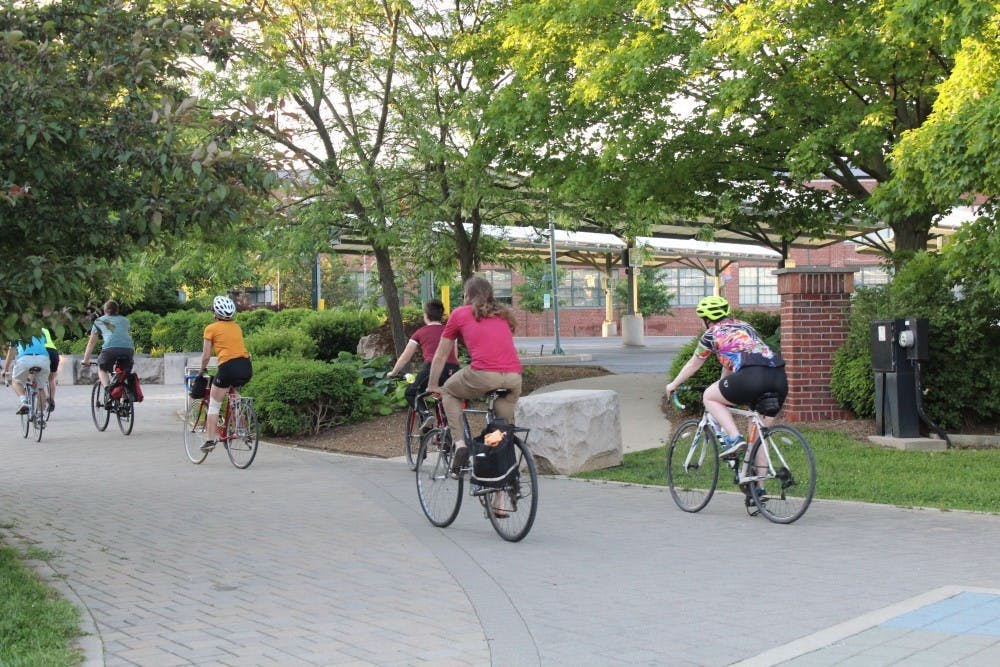A seemingly simple project to make a neighborhood street safer for cyclists and pedestrians has generated backlash from residents, reigniting a debate about who should have a voice in shaping the direction of Bloomington.
The Bicycle and Pedestrian Commission is in the midst of a project to add traffic calming devices like speed humps, curb bump-outs and speed cushions to Hawthorne and Weatherstone streets, which cut through the Elm Heights neighborhood south of campus.
The commission’s goal is to increase the safety of the greenway, which is a low-volume and low-speed road designed to be comfortable for cyclists and pedestrians, and to connect Hawthorne and Weatherstone streets.
Greenways are already a good option for cyclists because they aren’t high traffic roads. But greenways are shared between pedestrians, cyclists and cars, meaning that high-speed vehicles can cause significant damage in a crash. According to the project presentation, traffic calming can force cars to speeds of 15 miles per hour, which significantly reduces the likelihood of fatalities.
But most residents are opposed to the project, seeing it as an expensive, overengineered project for a street that is already safe, Councilmember Dave Rollo said.
“It’s a solution looking for a problem,” Rollo said.
Bloomington has had its share of accolades for bicycle infrastructure, including a gold-level rating from the League of American Bicyclists in 2018 and a second-place tie for the best cities for cyclists in Indiana. But the city has been unable to reach the highest rating, platinum, which only five cities hold.
In the meantime, cyclists still face issues with safety.
Matt Levy, an IU sophomore and informatics major, used to bike all the time in Bloomington. But on Sept. 29, 2021, Levy was hit by a car while crossing 10th Street on his bike.
He hasn’t biked in Bloomington since, and even after using crutches and wearing a boot, he still experiences pain in his ankle. Levy said protected bike lanes, where a curb separates cars and cyclists, is the only time he truly feels safe while biking.
He said he thinks it would be unrealistic to expect protected bike lanes everywhere, but that separating bike lanes with just a white line is not safe.
“It gives a lot of opportunity for human error,” Levy said.
[Related: Commit to commute safely at Indiana University this semester
Peter Dorfman is the editor of the blog The Dissident Democrat. The blog is a response to what Dorfman and other citizens see as a relentless and harmful pursuit of growth in Bloomington, from annexation to changes in zoning. Dorfman believes the way the greenways project is being done is part of this trend.
According to Dorfman, the issue is not with the attempt to make Bloomington more bike friendly but with the way it’s being done.
“The larger issue is that the city just does what it wants, irrespective of what the people in the neighborhoods affected want or object to,” Dorfman said.
In response to these types of sentiments from residents, Rollo introduced an ordinance in November 2022 that would amend the traffic calming and greenways program to give the city council final say before installation. The council decided to delay the decision for more information, Rollo said, but he plans to reintroduce the ordinance in February.
Rollo said the council is better suited to make this decision due to its access to the public and its traditional role in authorizing large expenditures. It was also standard procedure before the council gave its authority to the Bicycle and Pedestrian Safety Commission in 2019.
[Related: City accepting applications to serve on boards and commissions
Greg Alexander, a cyclist who serves on the Traffic Commission, said the Hawthorne and Weatherstone plan takes a good road and makes it great. The greenway connects the south side of the city to campus, he said, making it an important connector for cyclists.
Despite Hawthorne being a neighborhood street, there have been more than 100 traffic accidents at intersections along Hawthorne from 2003 to 2021, according to city traffic data. However, more than 60 of these incidents occurred at intersections at Atwater or Second Street, where a majority of crashes were on the cross street and wouldn’t be affected by the traffic calming program. Alexander refers to these streets as part of the high-injury network and said the greenways program was limited in this aspect.
Alexander himself has been hit by cars three times while cycling, although all accidents occurred in North Carolina, where he used to live. Still, Alexander worries especially while biking with his kids.
“This is a real policy that’s gonna decide life or death for our citizens,” he said.




